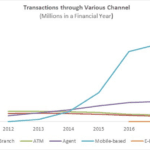Traditional Financial Services vs. FinTech – The Future of Money
Reconsidering Banking as a Platform
The traditional financial services industry has huge IT budgets and armies of brilliant thinkers dedicated to product design. It’s acutely aware of the opportunities represented by the roughly 2 billion unbanked adults around the world. Yet the industry struggles to innovate and create rapid change to address the needs of these underserved people.
The reality is that the industry needs more than just new products — it needs a new paradigm. I believe the concept of Banking as a Platform (BaaP) provides that new approach, presenting collaborative solutions and offering new value chains not only for banks and their partners, but also for related services such as payment processors, credit providers and mobile network operators (MNOs).
What is BaaP? In a nutshell, the concept refers to banks redefining their business to embrace innovation from outside the bank. Through modern applications, open interfaces, and collaborative business models they will open their doors to innovators that will build on the banks capabilities. This will change everything. I don’t think it’s an overstatement to say we will see a breakthrough similar to what we experienced when smartphone creators Apple and Google opened up their mobile platforms to application providers.
BaaP borrows from traditional financial services, morphing traditional solutions into innovative and vibrant communities. It is an opportunity to leverage communications technology advances to reconfigure today’s obsolete financial services system.
There are several driving forces for BaaP. They include:
- New generations of users who are mobile, socially-engaged, and desire superior financial tools
- Small and large businesses demanding scalable and more accessible banking services
- Rich and poor customers who equally deserve access to necessary financial products
- A digital, data-connected world filled with growing numbers of informed consumers
While not technically challenging, BaaP represents a huge culture change with implications for more than just technology. In fact, all aspects of the financial services business will need to evolve in order to support the diverse partnerships and communities BaaP requires. There are four layers of BaaP:
- Building blocks are essential elements that make everything else work well. Examples of building blocks are settlement networks like Faster Payments in the UK and Omney in the U.S. These systems allow larger networks of actors to safely perform real-time settlement of funds, allowing for interoperability and timely money transfers. Other critical building blocks are new models for credit rating and high tech identification systems. These building blocks make financial services and online commerce more efficient, safer and faster.
- Core systems, or those elements of financial services. For example, prepaid stored value processing, core banking financial backends, insurance underwriting engines, credit account processing, virtual currency, foreign exchange and anti-money laundering are all essential. Ninety-five percent of the IT investment in traditional financial services was in core systems; however, most cannot adapt to a BaaP world. SalesForce came out of nowhere to be a major player in enterprise customer relationship management, and new core systems providers have that same potential.
- Platforms combine building blocks and core systems to provide solutions. For example, Stripe is a payment platform, M-Pesa is a prepaid mobile money platform, Coinbase (US) and BitX (emerging markets) are bitcoin platforms. All of these companies are exposing application programming interfaces (APIs) to communities so they can incorporate existing applications or build new applications on top of them.
- Applications are what users of financial services experience. Simple, RushCard, Active Hours, Juntos, and Mint are all applications.
Dramatic advances in software technology over the past 40 years have brought us APIs. They allow other software programs to interact and use functionality without expensive and time-consuming programming, completely changing the way technical integrations are done. What could take years using old integration methods can now be accomplished in hours or days.
Companies that want to make it easy to integrate can do more than just have simple APIs; they also have “sandboxes,” which are developer portals for testing applications before deploying it to the production environment. Integrations can be fast and easy. The better the sandbox and APIs, the larger a partner community a company can build around its software.
The early proprietary mindset of the software industry that was built on a competitive advantage and IP ownership has slowly moved toward an alternative model—one of open systems. Linux is a well-known example, as is Bitcoin.
In open systems, the software is not owned or managed by one company. Instead, it is supported by a larger community of interested parties – small companies, individuals, large companies, or universities. This collaboration introduces new iterations rather quickly, and innovation, speed, and expanded functionality can happen even faster.
Bitcoin—the protocol, not the currency—is a perfect example of open systems, and has a major world advantage here with the number of actors feverishly working on applying and improving it daily.
You can already see movement toward the new paradigm. Banks are becoming more collaborative. New players like Stripe are opening up APIs and open-sourcing their platform. M-Pesa has published APIs for value-added service providers. Bitcoin’s advanced protocol is enabling innovators and new actors in core systems, platforms, and applications.
But for BaaP to succeed, there are a few things that need to happen. They include:
- Regulations that allow non-banks to offer financial services, lowering the barriers for customers to enter the banking system
- Graduated due diligence approaches, especially for the newly banked
- Support leaders who embrace change and dedicate themselves to inclusive services. Amex and MasterCard are leading the way, and others should follow
- Direct more institutional funding toward services for the bottom of the pyramid and emerging markets. Lots of money is chasing the next Square; why not divert some of that investment to deserving innovators working on financial services for the next billion?
- A revamped a culture of standalone proprietary solutions to one of collaborative approaches
In the past, financial services was considered a privilege. In the future, banking could consist of a global platform that’s open to all. By viewing banking as a platform, the industry can take the next step toward that future, leveling the steep sides of the global financial pyramid. If banks make this shift, then they will create large communities of innovators they can work with to grow transformation and help the underserved. The world of banking will never be the same.
Read more about BaaP and learn about real world examples of startups and banks collaborating to deliver financial inclusion around the world in Financial Inclusion at the Bottom of the Pyramid.
Carol Realini is the co-author of Financial Inclusion at the Bottom of the Pyramid.
Photo credit: Paulo and USAID Images/Flickr.
- Categories
- Technology



